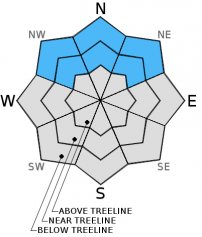| Tuesday | Tuesday Night | Wednesday | |
|---|---|---|---|
| Weather: | Mostly cloudy | Clear with a few clouds developing overnight | Partly cloudy to mostly sunny |
| Temperatures: | 43 to 50 deg. F. | 30 to 35 deg. F. | 42 to 50 deg. F. |
| Mid Slope Winds: | Southwest | Variable | Variable |
| Wind Speed: | 10 to 15 mph | Light | Light |
| Expected snowfall: | 0 | 0 | 0 |
| Tuesday | Tuesday Night | Wednesday | |
|---|---|---|---|
| Weather: | Mostly cloudy | Clear with a few clouds developing overnight | Partly cloudy to mostly sunny |
| Temperatures: | 40 to 45 deg. F. | 25 to 35 deg. F. | 41 to 48 deg. F. |
| Ridge Top Winds: | Southwest | Northwest | Variable |
| Wind Speed: | 15 to 25 mph with gusts to 35 mph | 10 to 15 mph with gusts to 25 mph becoming light after midnight | Light |
| Expected snowfall: | 0 | 0 | 0 |

























